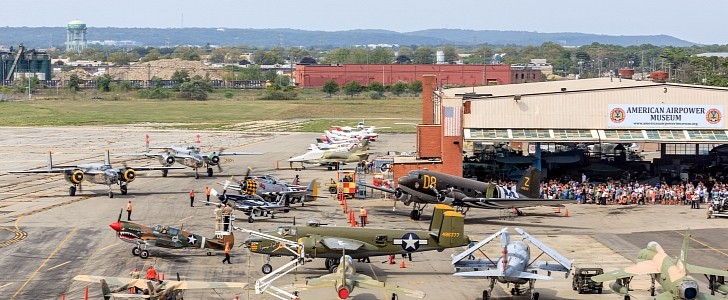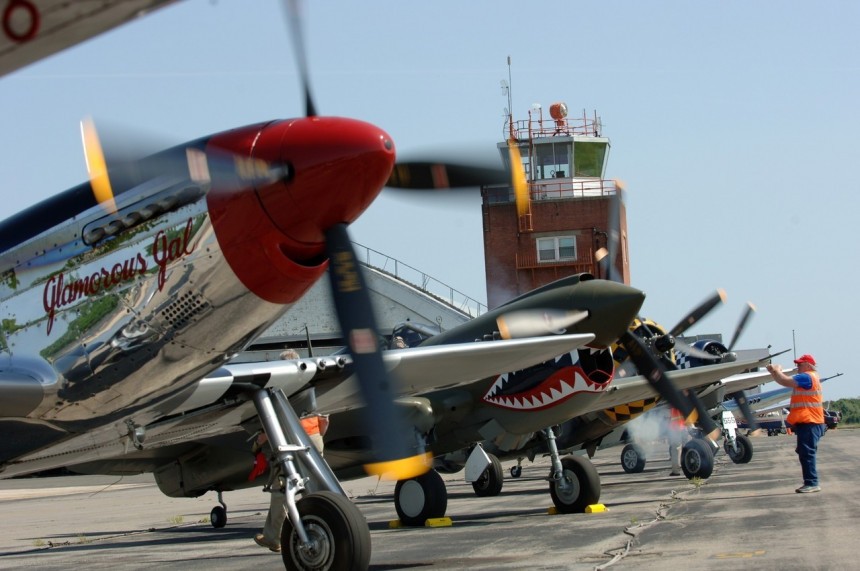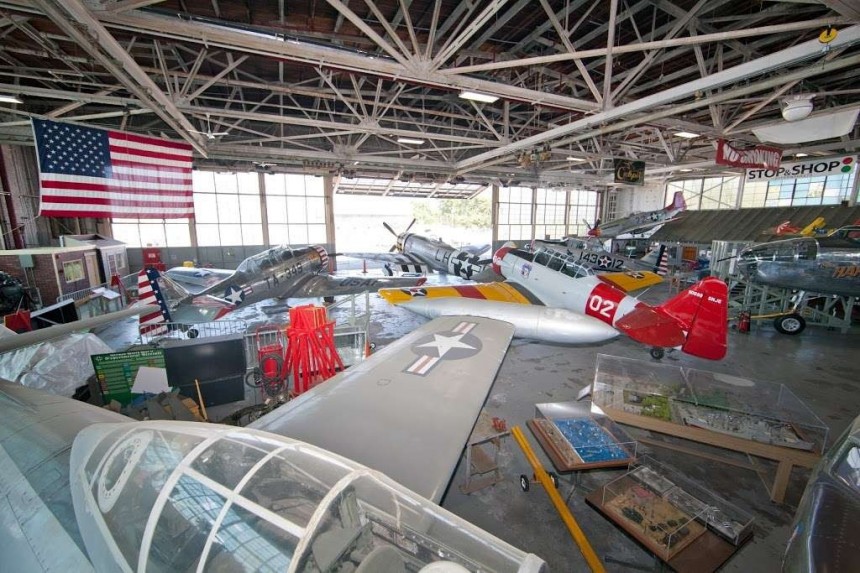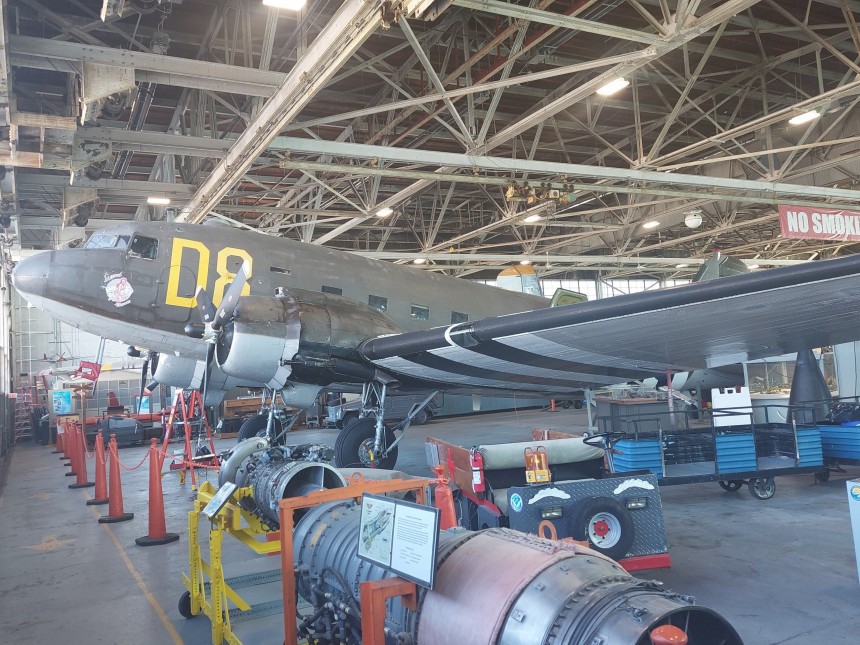The problem with most aviation museums has nothing to do with the quality of the exhibits, but something else altogether.
You can't help but think that the vast majority of the aircraft on display in these facilities will never, and we mean never, fly again. That may take away a bit from the authenticity of things for some people. But seeing them all couped up in hangars, never to leave in some cases, brings out the more human qualities of these machines, and their makers by extension.
But there's another kind of military aerospace museum for those people, one where the exhibits still fly, and recently to boot. Welcome to the former home of Republic Aviation, and the current home of the American Airpower Museum in Farmingdale, New York. One of only a handful of living warplane museums in the entire world. That's right, many of the two-dozen planes on display in this one hangar on the grounds of Republic Airport are in flightworthy condition. Better still, many of them have flown in the last 12 months.
On these hallowed grounds, famous planes like the P-47 Thunderbolt and the A-10 Thunderbolt II rolled off production lines at a facility that today only consists of a few remaining hangars, of which the museum is contained in only one, namely hanger three. But in the years before World War Two until as late as the early 80s, the Republic team produced some all-time iconic American aircraft in this very hangar at 1230 New Hwy, off of New York State Route 110.
The building was built by a gentleman whose aircraft company moved headquarters more times than most people will move house in their entire lives. Sherman Fairchild's aircraft company has called San Antonio, Texas, Hagerstown, Maryland, and Farmingdale, New York home at different points in their history. It'd one day purchase Republic Aviation when the latter fell on hard times in the mid-60s, but its eponymous founder needed a new runway to test his military aircraft with.
Existing dirt runways were insufficient, so Fairchild purchased the 77.967-acre (315,520 m2) stretch of land near the corridor of New York Route 24 and Conklin Street that would become Republic Airport. In those days, Republic Aviation was known as Seversky Aircraft, named for its founder, a Georgian Immigrant (as in the Russian Empire, not Atlanta) called Alexander de Seversky.
Seversky would move his production lines from a previous location in College Point, New York City, to a site at the Farmingdale Airport in 1935. By 1939, the company would be renamed Republic Aviation. From there, the team expanded the facility, ramping up production for what appeared to be a rapidly approaching Second World War.
The newly renamed Republic Aviation started with the pint-sized P-43 Lancer, the first fighter built under the new name. From the Lancer came its evolution (see what we did there?), the iconically rugged P-47 Thunderbolt. A great many of the 15,000-plus P-47 Thunderbolts ever made rolled off to war from this Long Island facility. Prat & Whitney R-2800 Double Wasp engines were shipped nearly fully assembled from East Hartford, Connecticut, to be bolted on and flown away as quickly as possible.
After the war, the facility transitioned to manufacturing jet-powered aircraft. Fighters like the F-84 Thunderjet, upgraded F-84F Thunderstreak, and experimental prop-jet XF-84 Thunderscreech. All in hopes of keeping up with advancing aerospace technology that was leaving the skies over battlefields looking far different than they did during World War II.
Modifications had to be made to the hangars at the Farmingdale facility to accommodate the XF-12 Rainbow, a quad-engined reconnaissance aircraft that was one of the fastest post-war piston-driven aircraft in the world. There were even plans for a civilian airliner based on the design at one point. The hangars housed the mockup for the XF-103, a proposed Mach 3-capable interceptor that never came to fruition in the mid-1950s
By the time of the Vietnam War, the Republic F-105 Thunderchief was prooving itself as a venerable fighter/bomber, serving alongside the McDonnell Douglas F-4 Phantom II and the Vought F-8 Crusader over the skies of Indochina. Legend has it the burly two-seater jet was surprisingly decent in a dogfight, having shot down more than a few MiG fighters in its day.
By that war's end, Fairchild had already acquired Republic, the company that allowed the makers of the Thunderplanes to move Farmingdale decades prior. Republic's last hurrah under the Fairchild banner turned out to be one of the all-time Air Force greats, the A-10 Thunderbolt II, or Warthog. A Warthog still stands guard parked outside the factory that built it, outside the museum. Many of its brethren still serve in the Air Force today.
By the beginning of the 1980s, production at the Republic factory had all but ceased. Never again would it be the thriving beacon of the Long Island industry it once was. There were even talks of demolishing the hangar that currently houses the Airpower Museum to make room for more emergency runway netting beside the adjacent airport.
But the FAA decided demolishing the 1940s vintage hangar was not necessary. In 1998, the hangar was purchased by Long Island businessman, philanthropist, and founder of the AVIREX clothing company Jeff Clyman, who secured a $250,000 grant from the state of New York to found one of the planet's very few living aviation museums.
Many of the two dozen or so aircraft on exhibit in the main hangar and just outside are in flightworthy or, at the very least, in towable condition. With a nominal donation to the federal 501 (c) (3) approved charity, people there may even allow you to sit in the cockpit of one. We spent an entire day at the museum checking out all the spectacular exhibits on display. Feel free to check out some of our other coverage from our trip right here on autoevolution.
But there's another kind of military aerospace museum for those people, one where the exhibits still fly, and recently to boot. Welcome to the former home of Republic Aviation, and the current home of the American Airpower Museum in Farmingdale, New York. One of only a handful of living warplane museums in the entire world. That's right, many of the two-dozen planes on display in this one hangar on the grounds of Republic Airport are in flightworthy condition. Better still, many of them have flown in the last 12 months.
On these hallowed grounds, famous planes like the P-47 Thunderbolt and the A-10 Thunderbolt II rolled off production lines at a facility that today only consists of a few remaining hangars, of which the museum is contained in only one, namely hanger three. But in the years before World War Two until as late as the early 80s, the Republic team produced some all-time iconic American aircraft in this very hangar at 1230 New Hwy, off of New York State Route 110.
The building was built by a gentleman whose aircraft company moved headquarters more times than most people will move house in their entire lives. Sherman Fairchild's aircraft company has called San Antonio, Texas, Hagerstown, Maryland, and Farmingdale, New York home at different points in their history. It'd one day purchase Republic Aviation when the latter fell on hard times in the mid-60s, but its eponymous founder needed a new runway to test his military aircraft with.
Seversky would move his production lines from a previous location in College Point, New York City, to a site at the Farmingdale Airport in 1935. By 1939, the company would be renamed Republic Aviation. From there, the team expanded the facility, ramping up production for what appeared to be a rapidly approaching Second World War.
The newly renamed Republic Aviation started with the pint-sized P-43 Lancer, the first fighter built under the new name. From the Lancer came its evolution (see what we did there?), the iconically rugged P-47 Thunderbolt. A great many of the 15,000-plus P-47 Thunderbolts ever made rolled off to war from this Long Island facility. Prat & Whitney R-2800 Double Wasp engines were shipped nearly fully assembled from East Hartford, Connecticut, to be bolted on and flown away as quickly as possible.
After the war, the facility transitioned to manufacturing jet-powered aircraft. Fighters like the F-84 Thunderjet, upgraded F-84F Thunderstreak, and experimental prop-jet XF-84 Thunderscreech. All in hopes of keeping up with advancing aerospace technology that was leaving the skies over battlefields looking far different than they did during World War II.
By the time of the Vietnam War, the Republic F-105 Thunderchief was prooving itself as a venerable fighter/bomber, serving alongside the McDonnell Douglas F-4 Phantom II and the Vought F-8 Crusader over the skies of Indochina. Legend has it the burly two-seater jet was surprisingly decent in a dogfight, having shot down more than a few MiG fighters in its day.
By that war's end, Fairchild had already acquired Republic, the company that allowed the makers of the Thunderplanes to move Farmingdale decades prior. Republic's last hurrah under the Fairchild banner turned out to be one of the all-time Air Force greats, the A-10 Thunderbolt II, or Warthog. A Warthog still stands guard parked outside the factory that built it, outside the museum. Many of its brethren still serve in the Air Force today.
By the beginning of the 1980s, production at the Republic factory had all but ceased. Never again would it be the thriving beacon of the Long Island industry it once was. There were even talks of demolishing the hangar that currently houses the Airpower Museum to make room for more emergency runway netting beside the adjacent airport.
Many of the two dozen or so aircraft on exhibit in the main hangar and just outside are in flightworthy or, at the very least, in towable condition. With a nominal donation to the federal 501 (c) (3) approved charity, people there may even allow you to sit in the cockpit of one. We spent an entire day at the museum checking out all the spectacular exhibits on display. Feel free to check out some of our other coverage from our trip right here on autoevolution.



















